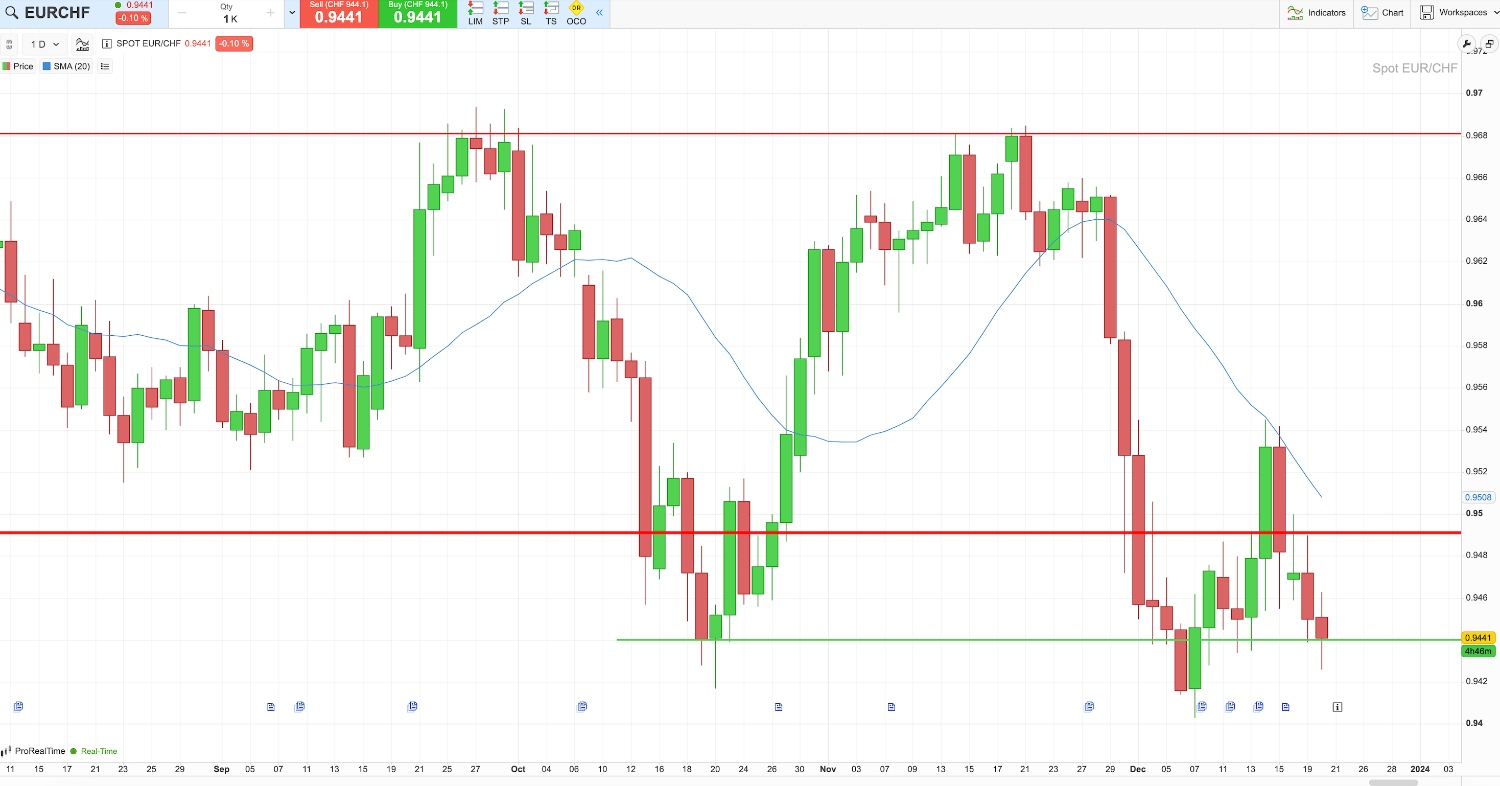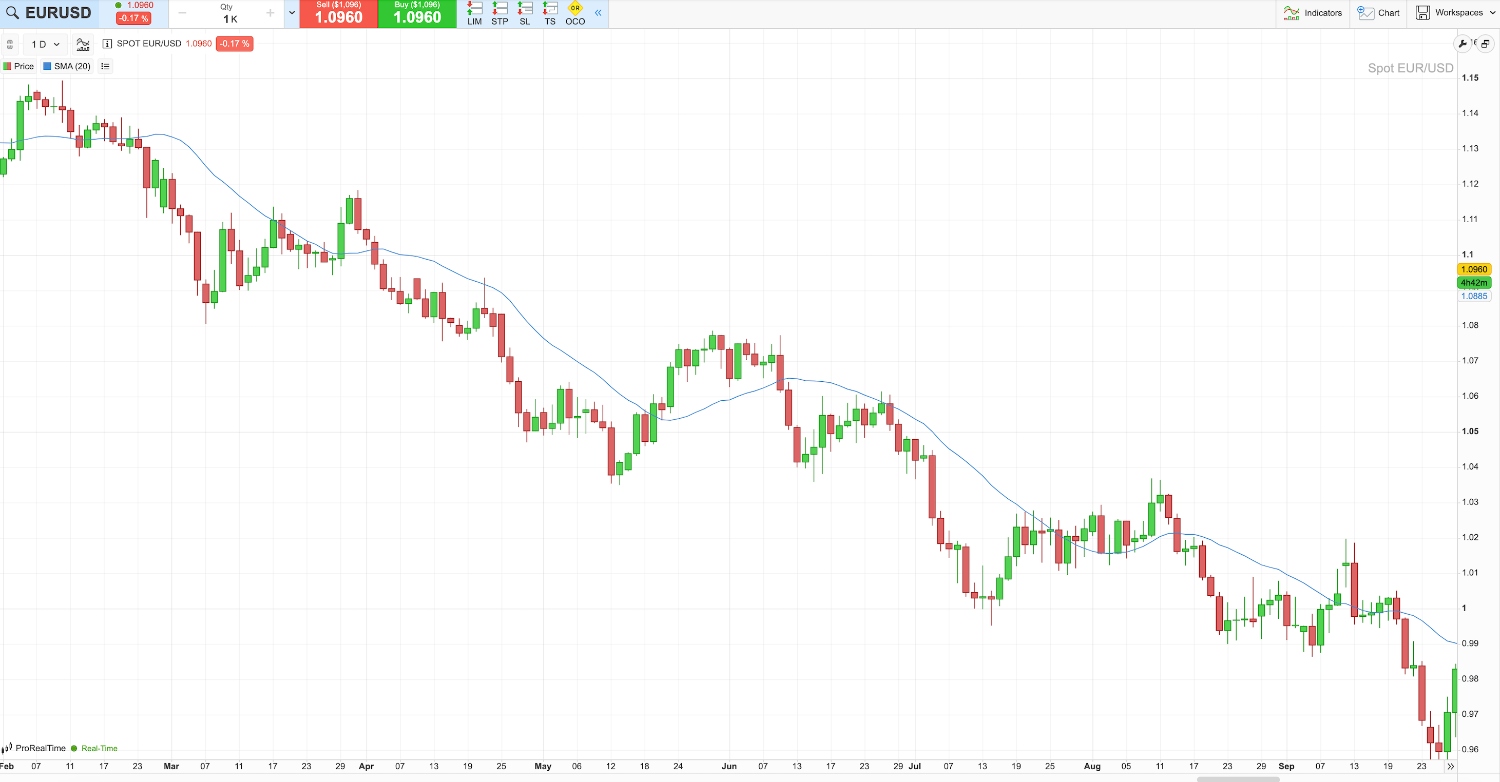Range Trading


Range trading is a robust approach if you are aiming to capitalize on market stability. From identifying trading ranges to leveraging indicators for optimal entries and exits, this guide aims to equip you with the tools needed to navigate range-bound markets.
Quick Introduction
- Range trading involves recognizing clear price boundaries within which an asset’s value fluctuates.
- You need to look for consistent highs and lows to establish these boundaries.
- You aim to buy at the lower end of the range and sell at the upper end, capitalizing on price swings within the range.
- Technical indicators can help confirm entry and exit points within the range.
- Implementing stop-loss orders and setting clear risk-reward ratios are crucial to mitigate the risks of sudden market reversals.
Best Brokers For Range Trading
These 4 brokers offer a wide selection of markets and excellent technical analysis tools for range trading:
-
1
 Interactive Brokers
Interactive Brokers -
2
 NinjaTrader
NinjaTrader -
3
 eToro USAeToro USA LLC and eToro USA Securities Inc.; Investing involves risk, including loss of principal; Not a recommendation
eToro USAeToro USA LLC and eToro USA Securities Inc.; Investing involves risk, including loss of principal; Not a recommendation -
4
 Plus500USTrading in futures and options involves the risk of loss and is not suitable for everyone.
Plus500USTrading in futures and options involves the risk of loss and is not suitable for everyone.
Understanding Range Trading
Range trading is a short to medium term strategy that capitalizes on the price oscillations within a defined range-bound market.
This approach aims to identify and exploit repetitive price movements within specific levels of support and resistance.
When employing this strategy you need to observe the high and low points of an asset’s price, delineating a range where the price fluctuates without breaking beyond these established boundaries – as you can see in my example below.

The primary goal of range trading is to buy an asset at the lower end of the established range and sell it at the upper end, profiting from these predictable price movements.
This strategy operates under the assumption that the asset’s value will continue to fluctuate within the identified range, offering you multiple opportunities to enter and exit positions.
One intriguing aspect of range trading is its emphasis on clear technical analysis. Understanding price behavior within defined boundaries provides structured entry and exit points that can potentially lead to consistent profits when managed skillfully.
Technical indicators like Bollinger Bands, Moving Averages, or the Relative Strength Index (RSI) are useful indicators to confirm entry and exit points within the range.
These tools can help to identify potential price reversals or breakout points, aiding in decision-making regarding when to buy or sell within the established range.
Successful range trading requires astute risk management practices. You need to set clear stop-loss orders and establish risk-reward ratios to protect against unexpected market movements that may breach the established range.
Moreover, understanding market conditions and recognizing when the range is likely to break is crucial.
This strategy tends to be most effective in stable market conditions where assets trade within well-defined limits, offering opportunities to exploit predictable price patterns.
Which Markets Are Suitable For Range Trading?
Range trading strategies are versatile and adaptable across various markets, encompassing forex, stocks, and cryptocurrencies.
The primary distinction lies in market volatility, directly impacting the range’s breadth. Instruments with higher volatility, like Bitcoin, entail amplified risk yet offer the potential for larger returns.
Optimal range trading forex pairs include currency crosses, excluding USD from the pair, leading to weaker trends. For instance, EUR/CHF exemplifies this trend due to similar growth rates in the European and Swiss economies.
While indices such as Nifty Bank and S&P 500 typically exhibit overarching growth trends, they also present opportunities for intraday range trading.
Range trading lets you capitalize on price movements within well-defined boundaries, offering opportunities for profit in both stable and consolidating markets, where price lacks a clear trend direction.
Pros & Cons Of Range Trading
- Clear Boundaries: Range trading operates within well-defined price boundaries, making it relatively straightforward to identify entry and exit points. Establishing specific levels of support and resistance helps to clarify decision-making.
- Reduced Risk: Range trading in stable markets tends to involve lower risk compared to other strategies. You can implement tighter stop-loss orders within the established range, mitigating potential losses if the price breaks out of the range.
- Multiple Trading Opportunities: Range-bound markets often exhibit repetitive price movements within the established range. This presents multiple opportunities to enter and exit positions as the price fluctuates within the defined boundaries.
- Predictable Price Movements: Range trading capitalizes on the predictability of price movements within the established range. This predictability lets you anticipate potential price reversals or bounces, aiding in decision-making for entries and exits.
- Adaptability: Range trading strategies can be applied to various financial instruments and markets, from stocks and currencies to commodities. You can utilize similar principles and techniques across different assets, allowing for versatility in your trading approach.
- Choppy Markets: Range-bound markets can be prone to choppiness and erratic price movements within the established range. These erratic fluctuations might trigger false signals or whipsaws, leading to potential losses.
- Limited Profit Potential: While range trading offers opportunities for consistent gains within the established range, it often limits the profit potential. You might miss out on significant price movements if the asset breaks out of the range, as you aim to capitalize on smaller price oscillations.
- Market Breakouts: One of the risks in range trading is the potential for a breakout beyond the established range. Sudden and significant price movements can breach the support or resistance levels, causing you to incur losses if your positions are not protected with appropriate risk management tools like stop-loss orders.
- Timing Challenges: Effectively timing entries and exits within the range can be challenging. You might face difficulties in accurately identifying the turning points or reversals within the established boundaries, leading to missed opportunities or entering positions at less favorable prices.
- Market Conditions: Range trading is most effective in stable, range-bound markets. In highly volatile or trending markets, the price may break out of the established range, making range trading less suitable. You need to adapt your strategies to prevailing market conditions, which can limit the effectiveness of range trading in certain scenarios.
Correctly Using Stop Losses
When setting stop losses in range trading, you need to consider the volatility of the asset and the width of the established range. Consider my advice for setting stop losses in range trading:
- Outside The Range: Place your stop loss orders outside the established range to guard against potential breakouts. This can be beyond the support or resistance levels that define the range. The distance outside the range should account for potential volatility and provide a buffer against false breakouts.
- Volatility-Based Stops: Consider using volatility-based indicators or average true range (ATR) to determine stop levels. Volatility measures can help assess the typical price fluctuations and set stops accordingly. A wider stop might be necessary in more volatile conditions, while lower volatility might allow for tighter stops.
- Support & Resistance: Base your stop loss levels on significant support or resistance levels within the range. Placing stops just beyond these critical levels can provide protection against false breakouts or sudden price reversals.
- Risk-Reward Ratio: Ensure your stop loss aligns with your risk-reward ratio. Factor in the potential loss against the anticipated profit within the range. Adjust the stop distance based on your trading plan and risk tolerance to maintain a favorable risk-reward ratio.
- Adaptability: Be adaptable with your stop losses. Adjust them as the market conditions change or as the price action evolves within the established range. Regularly review and update your stop loss levels to reflect changes in volatility or any new support/resistance levels forming within the range.
Range Trading With Bots
Automated algorithmic robots are capable of executing range trading strategies seamlessly.
For instance, a bot can be programmed to initiate a buy order when the price surpasses the support band, and trigger a sell order upon crossing below the resistance level. Simultaneously, it can open a new sell trade.
Various trading bots are accessible through different libraries, depending on the trader’s platform preference. For instance, MetaTrader hosts a range of bots known as Expert Advisors (EAs) tailored for range trading. Each EA allows customization of variables like lot size, resistance, and support limits.
You also have the option to create custom bots by coding your unique trading algorithms, enabling precise control over range setup and risk management. These bots are developed using platform-specific programming languages, such as MQL, supported by MetaTrader platforms.
Range Trading Vs Trend Trading
Range trading and trend trading represent two distinct approaches, each with its own principles and strategies.
Range trading revolves around exploiting price oscillations within a defined range-bound market. When trading within ranges you need to identify specific levels of support and resistance, marking the boundaries within which an asset’s price fluctuates to buy at the lower end of the established range and sell at the upper end, capitalizing on repetitive price movements.
This strategy operates under the assumption that the asset’s value will continue to fluctuate within the identified range, providing multiple opportunities.
On the other hand, trend trading focuses on capitalizing on directional price movements by identifying and riding market trends.
When trend trading you aim to profit from the sustained upward or downward movement of an asset’s price, as you can see in my example below.

You will enter positions in the direction of the prevailing trend, either upward (bullish) or downward (bearish), and hold onto these positions until the trend shows signs of reversal.
Trend trading strategies employ technical analysis tools to identify trends and indicators that signal potential entry or exit points in line with the ongoing trend.
The key difference between the two strategies lies in their fundamental approach to market movement. Range trading targets predictable price oscillations within established limits, while trend trading seeks to capture gains from sustained directional movements, whether upward or downward.
Bottom Line
Range trading proves adaptable across diverse financial markets in the absence of a distinct trend direction. The challenge often lies in pinpointing the support and resistance levels within the range. However, once these boundaries are established, the buying and selling positions become evident.
FAQ
Is Range Trading Profitable?
Range trading can be profitable if you effectively identify and trade within established price ranges. Success often hinges on skillfully recognizing support and resistance levels, implementing effective risk management, and adapting strategies to market conditions.
However, profitability can vary based on individual trading approaches, market volatility, and the ability to navigate potential breakouts or false signals within the range.
What Is A Range Trading Strategy?
A range trading strategy involves identifying specific price levels where an asset oscillates within a defined range, typically bounded by support and resistance. You’ll aim to buy near support and sell near resistance, capitalizing on the predictable price movements within this established range.
The strategy involves frequent buying and selling within the range, seeking to profit from price oscillations while avoiding breakouts beyond the established boundaries.
Is Range Trading A Swing Trade?
Range trading shares similarities with swing trading due to their focus on exploiting short to medium-term price movements. Both strategies involve entering and exiting positions within a certain time frame, aiming to capitalize on price oscillations.
However, while range trading centers on buying near support and selling near resistance within a defined price range, swing trading may encompass a broader approach, seeking to profit from both upward and downward swings in price trends across varying market conditions.
Is Range Trading Better Than Trend Trading?
The effectiveness of range trading versus trend trading depends on market conditions, personal trading preferences, and skill sets. Range trading suits stable markets without clear trends, allowing you to profit from predictable price movements within established boundaries.
On the other hand, trend trading is favored in markets with clear directional movements, aiming to capitalize on sustained price trends.
There’s no definitive ‘better’ approach and success lies in your ability to adapt strategies to prevailing market conditions and execute them effectively.
Article Sources
The writing and editorial team at DayTrading.com use credible sources to support their work. These include government agencies, white papers, research institutes, and engagement with industry professionals. Content is written free from bias and is fact-checked where appropriate. Learn more about why you can trust DayTrading.com